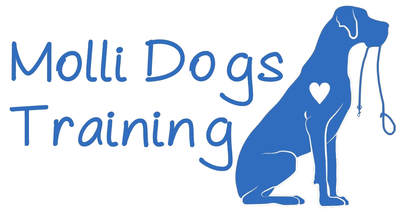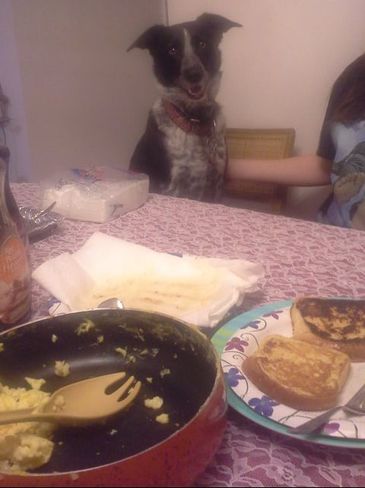Counter Surfing
Management:Management is a key component to any training plan. When we can't monitor our dogs and actively work on training them, we need to keep them away from the counters when food is out and we need to keep the counters clean and free of reinforcers when the dog has unmonitored access to the counters. Using gates to prevent access to these areas when you are not around can be helpful in the beginning stages.
Teach an Incompatible Behavior: Next we want to teach our dogs an incompatible behavior with counter surfing. A big thing we want to avoid is teaching our dogs the following chain: Counter surf > Cue Off > Dog gets down > Dog gets rewarded. If you get stuck in this chain, your dogs will never stop counter surfing. They will simply think it is a part of the chain to get a reward. Having your dogs do a Sit or a Down is incompatible with jumping up on the counter, and can help. If you use these cues, make sure you wait for at least 5 seconds and build your dogs up to holding it for longer and longer periods before receiving the reward. We want the dogs to understand that it is the incompatible behavior to the counter surfing that is being rewarded. Teaching a Place command is a great solution. It gets your dogs far away from temptation, and teaches them a new location that is highly rewarding. You can build your dogs duration for how long they will stay on the place easily by giving them activities to work on at their place. Any time you are going to give your dog something rewarding, like a treat, something to chew on, food, etc. it should come from their place. |
Apply the Premack Principle:
Competing reinforcers are the things in the environment which reward the undesirable behavior and are more rewarding than whatever we're offering for the desired behavior. Competing reinforcers are often the reason that people think they're pet is "being stubborn." In reality, we ALL will choose the consequence which pays the most. If you're shopping for clothes and find two outfits that cost around the same, but one is more comfortable and flattering than the other, which outfit will you purchase? That is a competing reinforcer. If we're asking our dogs to leave our delicious dinner alone and go to their place, and all we have to offer is kibble, praise, petting, or a toy, more often than not we'll end up with an unreliable behavior. Why? Because we're asking the dog to give up a $20 so we can pay them $5.
The way to deal with competing reinforcers is to use them (as much as possible) as the reward for the desirable behavior. This is called the Premack Principle: if you do what I ask, you get what you want.
How does this work? As long as the food on our counter doesn't make our dog sick, we use it to reward them for going to their Place: Dog smells food > Cue Place > Dog goes to place and stays there for the amount of time they currently know how to stay > Mark and reward with small piece of food from counter.
Over time, the dog learns that the counter never pays, but the Place always does. The smell of the food on the counter becomes the cue for going to Place, and the dog will go there automatically. At that point we can switch to an intermittent schedule of reinforcement so we don't *always* have to pay them to go to their Place, or we can use lower value rewards, and only every once in a while will we bust out the counter food again as a jackpot.
The way to deal with competing reinforcers is to use them (as much as possible) as the reward for the desirable behavior. This is called the Premack Principle: if you do what I ask, you get what you want.
How does this work? As long as the food on our counter doesn't make our dog sick, we use it to reward them for going to their Place: Dog smells food > Cue Place > Dog goes to place and stays there for the amount of time they currently know how to stay > Mark and reward with small piece of food from counter.
Over time, the dog learns that the counter never pays, but the Place always does. The smell of the food on the counter becomes the cue for going to Place, and the dog will go there automatically. At that point we can switch to an intermittent schedule of reinforcement so we don't *always* have to pay them to go to their Place, or we can use lower value rewards, and only every once in a while will we bust out the counter food again as a jackpot.
Make the Floor More Rewarding:
To really gain fluency at not counter surfing, we need to have a training plan in place which doesn't require our presence. The easiest way to do this is to make the floor pay. A lot. Every day. All the time. Hide random treats and food on the floor throughout the house for your dog to find. Food puzzles also can be hugely helpful. If you want, you can feed your dog entirely out of food puzzles that are scattered and/or hidden around the house, or, set aside enough food that they can still have multiple food puzzles scattered around for them to fine. Cheerios can also be a great option to use in food puzzles.
If the counter never pays but the floor always pays, where do you think your dogs are going to look for food? Even when you're gone? Even when you leave food on the counter?
By doing this, the environment can continue to train the dogs for us even when we're not around. We want to work smarter not harder.
If the counter never pays but the floor always pays, where do you think your dogs are going to look for food? Even when you're gone? Even when you leave food on the counter?
By doing this, the environment can continue to train the dogs for us even when we're not around. We want to work smarter not harder.
Special thanks to Emily Strong with From Beaks to Barks on collaborating with me on this and providing me with so much awesome information to help put this together!

